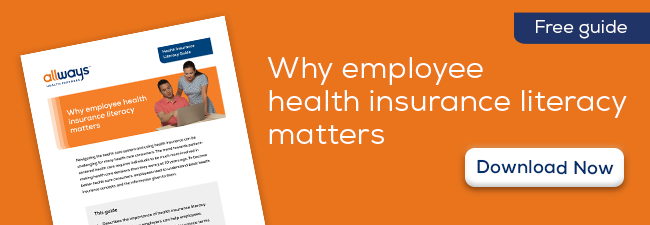Why employee health insurance literacy matters [Free guide]
Health plan members are often confused by the alphabet soup of acronyms, terminology, and lingo used to describe their health insurance. Whether they’re trying to choose a health plan or take advantage of the benefits offered, understanding insurance terminology can be like reading another language.
Bottom line: A poor understanding of basic health insurance terms makes an already complicated subject even more confusing. In fact, two national studies revealed that only 4% to 14% of individuals were able to accurately respond to a set of questions that addressed the basic understanding of health insurance.
Yet, understanding the ins and outs of health insurance is crucial to effectively accessing health care services and making the most of one’s health coverage.
Download this guide + health insurance glossary
As an employer or benefits advisor, you want your employees or those of your clients to understand insurance basics so they can become better health care consumers. This not only helps ensure satisfaction with their coverage, but it also gives them the confidence to evaluate health insurance plans, select the plan that best meets their needs, and, most importantly, to use the plan to its maximum benefit once enrolled.
Health insurance illiteracy is real
Given the complexity of health insurance it’s become clear that health insurance illiteracy is real. A report from Alegeus, a provider of consumer driven health solutions, revealed the majority of consumers with employer-sponsored health plans lack the necessary financial health literacy to optimally manage their health plan finances.
According to a Policygenius article that described a 2019 literacy survey, health literacy is a fairly new phenomenon. “If you shift the frame back say, even 20 years ago, people didn’t know what [medical treatment] cost, but it didn’t matter because their insurance company just covered it,” Christine Wilson, a spokesperson for the National Patient Advocate Foundation, observed. Today there is much more variation in how benefits are covered and what types of cost sharing may apply. And the growth of tools such as health reimbursement arrangements and health savings accounts have further complicated the landscape. The same Policygenius survey found that more than two-thirds of respondents could not correctly define even basic insurance terms, such as premium, deductible, and copay.
Another health insurance literacy survey by the Kaiser Family Foundation revealed many were able to answer some basic questions, like when premiums are paid. Questions involving calculations, however, proved more difficult. Only 51% of those surveyed could determine the out-of-pocket charges for a hospital stay where a deductible and copay were involved. And just 16% could calculate the cost of an out-of-network lab test where the health insurer paid a percent of allowed charges. Further, only one-third of survey respondents correctly defined a formulary.
When health care consumers don’t have a good understanding of the system, it can lead them to make poorly informed decisions about their care. For example, they may choose a plan based on premium alone, instead of also evaluating the possible out-of-pocket costs, network access, and benefit value. Fortunately, this is a mistake that can be avoided with some basic knowledge and education.
Low health literacy linked to delaying or avoiding care
Research has also shown that health insurance literacy (or lack of) is a factor that contributes to consumers delaying or not seeking care. And that includes preventive care, which is often covered by insurance with no cost sharing to the consumer.
Almost 30% of respondents to a national survey reported delaying or foregoing health care because of cost. Specifically, those with lower health literacy reported significantly greater avoidance of both preventive and non-preventive services. Understanding the types of services available, what’s covered and at what cost, can help individuals use their health plan wisely and obtain recommended health services. This trend toward foregoing care was also reported in a Policygenius study where 27% claimed uncertainty over their coverage led them to avoid treatment.
In addition to delaying or avoiding important care, poor health literacy can also lead consumers to:
- Not understand the additional costs associated with out-of-network care
- Remain with the same plan year in and year out when a better alternative is available
- Not take full advantage of shopping for prescription drugs to save money
These situations create higher costs for them and for employers.
Acknowledging the problem is the first step
To address the challenge of health literacy, there are many initiatives in place by policymakers, payors, providers and employers. For example, the independent nonprofit Consumers Union (CU) confirmed that this lack of understanding was taking a toll on consumers’ health and financial well-being, and agreed that a widely accepted measure of consumer health insurance literacy was needed. Now called the Health Insurance Literacy Measure, it represents a self-assessment measure of consumers’ ability to select and use private health insurance.
This measurement is based on a conceptual framework that breaks health insurance literacy into four different components:
- Knowledge, or recognizing the importance of understanding insurance terminology
- Information seeking behaviors, or understanding the questions to ask and where to find the answers
- Document literacy and being able to interpret benefits and explanation
- Cognitive skills, which includes an ability to calculate cost sharing, and assessing value based on cost vs. benefits
By measuring health insurance literacy and recognizing the components that contribute to this phenomenon, we can shape consumer education, policy development, and research around health insurance experiences. Additional efforts by the Department of Health and Human Services have elevated health literacy as a priority, as has the development of public marketplace exchanges.
What employers can do to help improve health literacy
Investment in employee health demonstrates a commitment to keeping employees happy, healthy, and engaged at work. By being proactive in improving health literacy, employers will help their workers make the most of their health plan coverage, potentially reducing health care costs for both parties.
Here are 5 ways employers can start improving health literacy at their organization:
- Survey employees to evaluate their understanding of health insurance terms and concepts before, during and after the annual benefits period. You can use these insights to specifically address the areas where your employees are uninformed.
- Set up enrollment sessions or hold lunch and learn sessions with employees to share real examples of smart health care decisions. This offers employees the potential to save money on health care that can be used for other aspects of their lives.
- Look at what your insurance carrier offers to support its members in understanding their health insurance benefits, including educational content, subscriber portals, online cost calculators, and mobile apps.
- Tap into your benefits advisor or consultant as a resource. They often have tools that can help.
- Share the glossary in the full version of this guide, either in benefit communications with employees, benefits brochures, employee newsletters, your online employee portal that describes benefits, or any place you communicate with employees.


